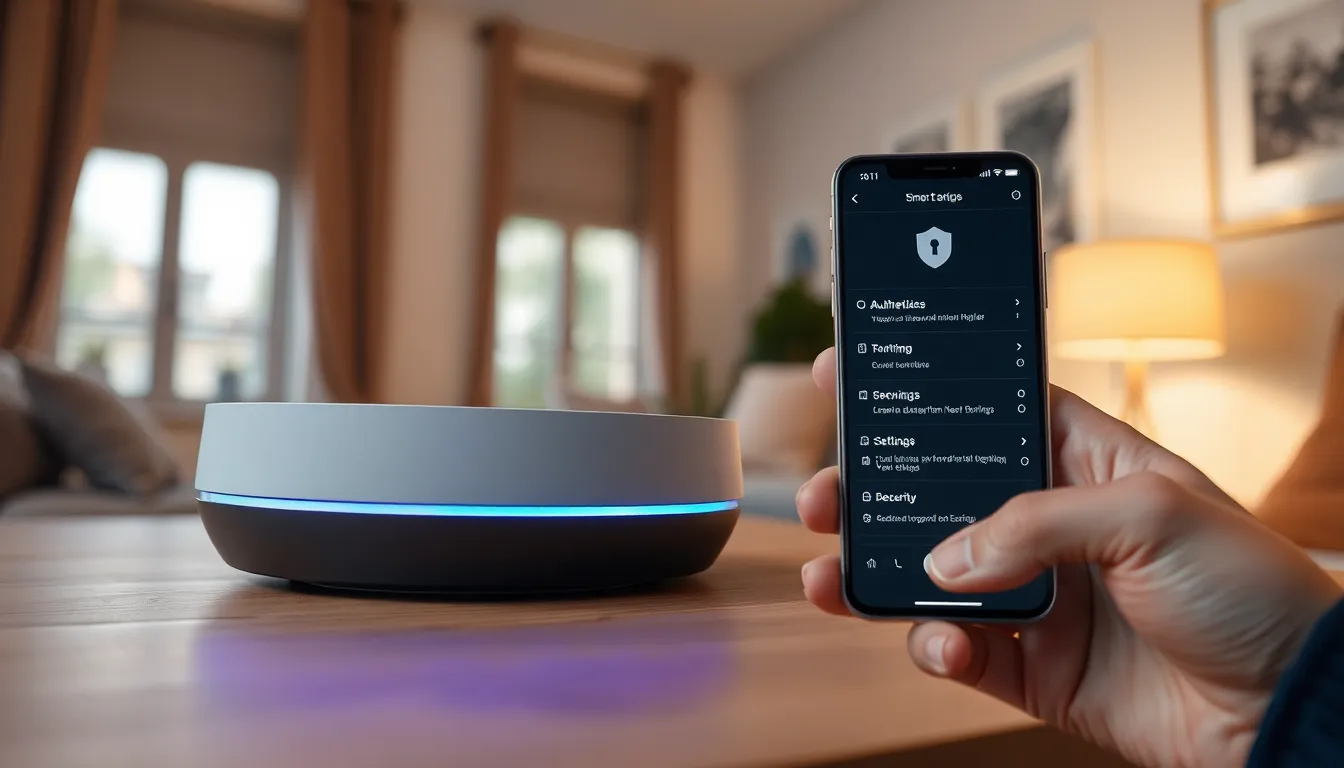In a world where your toaster can chat with your fridge, the Internet of Things (IoT) is revolutionizing everyday life. But while smart devices promise convenience, they also open the door to a digital Wild West. Imagine your smart thermostat spilling the beans about your vacation plans to a hacker. Yikes!
As homes become more connected, the security risks multiply faster than a cat video on social media. From unsecured baby monitors to vulnerable wearables, it’s clear that not all IoT devices are created equal. Understanding these security issues isn’t just a techie concern; it’s essential for anyone who wants to keep their digital life safe and sound. Buckle up as we dive into the quirky yet crucial world of IoT security issues.
Table of Contents
ToggleOverview of Internet of Things Security Issues
The Internet of Things (IoT) introduces numerous security challenges. Vulnerabilities in devices, like smart cameras and home assistants, provide entry points for cyberattacks. Insufficient encryption allows attackers to intercept data easily. With over 35 billion connected devices by 2025, the threat landscape is expanding rapidly.
Insecure devices frequently lack essential security updates. Many users neglect to change factory-set passwords, making them easy targets. The potential for mass exploitation increases when multiple devices connect to a single network. Malware designed for IoT can disrupt operations and steal sensitive information.
Interconnected systems elevate risks associated with data privacy. Personal information stored in smart devices, such as health monitors and smart speakers, can become exposed. Not only can attackers access these devices, but they can also manipulate them to gather more data.
Security regulations lag behind technological advancements, creating a gap. Organizations struggle to implement robust security protocols due to a lack of awareness and resources. Stakeholders must understand the necessity of proactive measures to safeguard networks and devices.
Educating users about basic security practices is crucial. Installing security patches, using strong unique passwords, and routinely monitoring device activity enhance safety. Individuals and businesses alike benefit from adopting these strategies to mitigate risks associated with IoT.
Common Security Vulnerabilities

Numerous security vulnerabilities exist within the Internet of Things (IoT), posing threats to users and their data.
Device Authentication Challenges
Authentication processes for IoT devices often lack rigor. Many devices use weak credentials or default settings, making unauthorized access easy. Manufacturers frequently overlook the importance of implementing robust authentication methods. Inadequate verification measures can expose networks to cyberattacks. Users often forget to change factory-set passwords, which leaves devices vulnerable. Increased reliance on simple password authentication compounds the problem. Incentives exist for manufacturers to prioritize security features to protect consumers effectively.
Data Encryption Gaps
Encryption remains a significant concern in IoT security. Many devices transmit sensitive information without proper encryption, which leaves data exposed. Unsecured data can be intercepted by cybercriminals with relative ease. Users’ personal and financial information often resides in smart devices, making strong encryption essential. Lack of comprehensive data protection protocols contributes to increased risks. As connected devices proliferate, the need for manufacturers to enforce strong encryption practices grows. Effective encryption solutions can significantly mitigate potential breaches.
Threats to Internet of Things Devices
IoT devices face various security threats that jeopardize user safety and privacy. These threats can have far-reaching consequences as more devices connect to the internet.
Malware and Ransomware Attacks
Malware specifically designed for IoT devices exploits vulnerabilities for unauthorized purposes. IoT botnets, such as Mirai, demonstrate the risks of compromised devices, using them to launch DDoS attacks on major websites. Ransomware attacks target connected devices, locking users out until they pay a ransom. Owners of smart devices find themselves vulnerable if proper security measures aren’t in place. Regularly updating device firmware remains essential to defend against these attacks. The increasing complexity of IoT systems makes users prime targets for malicious software, emphasizing the need for vigilance.
Unauthorized Access and Control
Unauthorized access presents a significant risk to IoT devices. Weak default passwords often remain unchanged, facilitating easy entry for hackers. Attackers gain control over home assistants, security cameras, and other smart devices, using them for malicious purposes. Public Wi-Fi networks further exacerbate this problem, allowing attackers to intercept data. It’s crucial for users to implement strong, unique passwords and utilize two-factor authentication where available. Increased awareness about these threats helps consumers take proactive steps to secure their devices from unauthorized control, ultimately enhancing overall security.
Best Practices for Enhancing Security
Implementing best practices enhances the security of Internet of Things devices. Key strategies involve regular software updates and strong password policies.
Regular Software Updates
Regular software updates play a crucial role in maintaining device security. Updates often include critical patches that fix vulnerabilities exploited by cybercriminals. Users should enable automatic updates when possible to ensure timely installation of new security features. Failing to update devices leaves them susceptible to known threats, which can lead to unauthorized access and data breaches. Manufacturers typically release updates periodically, highlighting the need for users to stay informed about their devices’ software status. Maintaining up-to-date firmware contributes significantly to minimizing risk exposure.
Implementing Strong Password Policies
Implementing strong password policies significantly strengthens device security. Unique and complex passwords should replace factory-set ones, as default passwords are easily compromised. Users must avoid common phrases and create passwords containing a mix of letters, numbers, and symbols. Adopting two-factor authentication enhances security further, adding an extra layer that protects account access. Regularly changing passwords can also help mitigate risks associated with unauthorized access. Educating users on password management tools can assist in maintaining unique passwords across devices, empowering them to defend against potential cyber threats.
Future Trends in IoT Security
Growing integration of artificial intelligence in IoT security represents a significant trend. AI algorithms can analyze vast amounts of data to detect unusual patterns, improving threat detection and response times.
Increased focus on privacy regulations shapes the landscape. New laws like the General Data Protection Regulation (GDPR) influence manufacturers’ approaches towards data handling and user consent, resulting in better security practices.
Emergence of edge computing plays a crucial role in security enhancement. By processing data closer to the source, it reduces latency and limits data transmission, decreasing potential exposure to attacks.
Adoption of blockchain technology provides a decentralized solution to security issues. Blockchain can secure transactions and verify the legitimacy of devices within the IoT ecosystem, thus minimizing risks associated with unauthorized access.
Enhanced device authentication methods improve security protocols. Multi-factor authentication and biometrics offer higher levels of security, addressing weaknesses found in many devices today.
Collaboration between stakeholders encourages the development of standard security frameworks. Industry partnerships aim to establish best practices that manufacturers can implement, leading to more secure IoT ecosystems.
Regular security audits become vital as the number of connected devices grows. Organizations are prioritizing comprehensive assessments to identify vulnerabilities and maintain compliance with evolving regulations.
Investments in user education help fortify IoT security. Increased awareness about security measures equips users to better protect their devices and data from cyber threats.
The rise of IoT devices brings undeniable convenience but also significant security challenges. As the number of connected devices continues to grow the potential for cyber threats increases exponentially. Stakeholders must prioritize robust security measures to protect sensitive data and personal information.
User education plays a crucial role in this landscape. By understanding basic security practices and adopting strong passwords users can significantly reduce their vulnerability. The collaboration between manufacturers and users is essential for creating a safer IoT environment.
Investing in advanced security technologies and staying informed about emerging threats will be vital in navigating this evolving digital landscape. The future of IoT security hinges on proactive measures that ensure safety and privacy for everyone involved.






